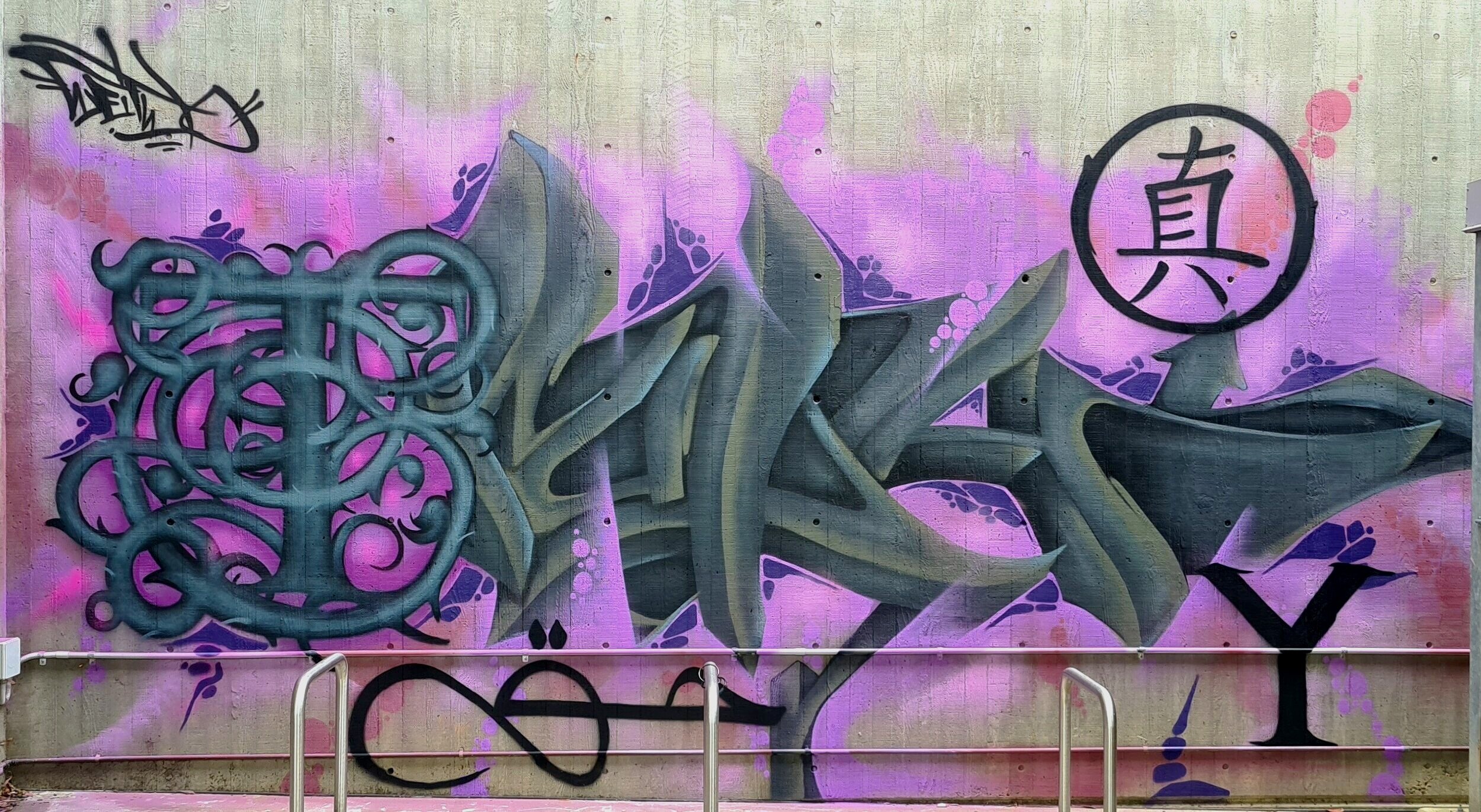All of the below art works were produced in 2020, and tie into my Masters of Research at Macquarie University in the Media, Music, Communication and Cultural Studies Department. They are political messages which reflect the nature and quality of graffiti writing, and the dialectical politics of conscience inherent in the subculture. They are intended to represent authentic graffiti writing by bridging the gap between the illegality of the subculture and the loss of substance when graffiti is appropriated by commercial uses of the aesthetic. These pieces I hope show graffiti writing for what it is: an appreciation of letter forms, and a politically powerful form of visual and cultural communication capable of traversing the subcultural and fine art worlds. All pieces were made for my research project, most were exhibited using campus gallery space. The mural can be viewed in person behind the Macquarie University Theater in the quad.
“Post-Truth” 5 x 4 meters, aerosol.
“I shouldn’t be forced to see that!” 60 x 90 cm, paint pen on digital print.
This carousel shows a series of digital art works which counter-critique criticisms leveled against graffiti.
Click right or left to view.
In order from left to right:
“Ego Mania”. Graffiti is criticized for being ego-driven and is often visually represented by the repetition of a single word written time and again. For some, this suggests attention seeking or the imposition of the ego onto the world. However, our culture is laden with the egocentric image as shown by the images in the collage, while graffiti is often anonymously written - the identity of the writer usually reserved only for those in the inner circle.
“Gangster”. Graffiti crews (groups of friends and associates who write graffiti together) are often labelled gangs. So are organised crime groups who - for financial gain - practice international drug and human trafficking and are renowned to use severe violence to achieve their ends. To associate graffiti crews with these dangerous criminals is ludicrous. At the same time, many legal groups exist such as far right factions, the police, military and large corporations who exact systemic harm on others and who represent a threat to the overall well being of our societies. Applying paint to various surfaces is a far cry from the actual harm these other groups cause. Who are the real gangsters?
“Eyesore”. Many claim graffiti is ugly. However, as the images in the collage show - minimal if any aesthetic consideration is given to much development the world around. Skyscrapers jutting into a once beautiful landscape, “functionality” given precedence in much modern architecture, stripping the potential ornate beauty from the built environment for the sake of productivity and industry resulting in the post-human battery hen. Graffiti is a response to this gross inhumane injustice, and whether intended to be “pretty” or not, it draws attention to this.
“Qualia”. Is a term used in phenomenology to describe the qualities of perception. Graffiti has been called a “quality of life crime”. Meanwhile, our culture permits heavily sexualised imagery resulting in crippled self-esteem, exploitation of the female form, and the normalization of pornography. A fast food industry causing an obesity crisis, magnates who exploit the vulnerable for the sake of personal greed, and factory work, where individuals monotonously labor for minimum wage to serve the aforementioned ends of said magnates. But graffiti is singled out as a crime against apparent positive qualities of life, while widespread legal and culturally normative qualia is free to corrode the human spirit. The hypocrisy is glaring, and such criticism of graffiti is simply misdirected.
“Cash”. Many attempt to justify the criminalisation of graffiti due to the cost of its removal, despite its removal being optional. Billions of dollars are spent annually on a huge range of novel purposes, by design serving no purpose other than entertainment or indulgence. Graffiti writers practice their art usually at the expense of their finances and time - for the sake of what they experience as a higher purpose.
“You Cant Even Read It”. Perhaps the laziest of the criticisms against graffiti. Not being able to decipher the lettering does not mean it is illegible. It only means certain people are too lethargic to bother to understand an art form. Part of the point of the complexity of much graffiti is to deepen its conceptual content. Many individuals only read and speak a single language, but are tolerant of the existence of other languages they cannot read. There are so many cases where understanding requires effort, and to apply that effort is to develop ones character. Rather than this, many dismiss graffiti on the grounds that it is not easy for them to read. Well neither is Finnegans Wake, but it is worth it.







